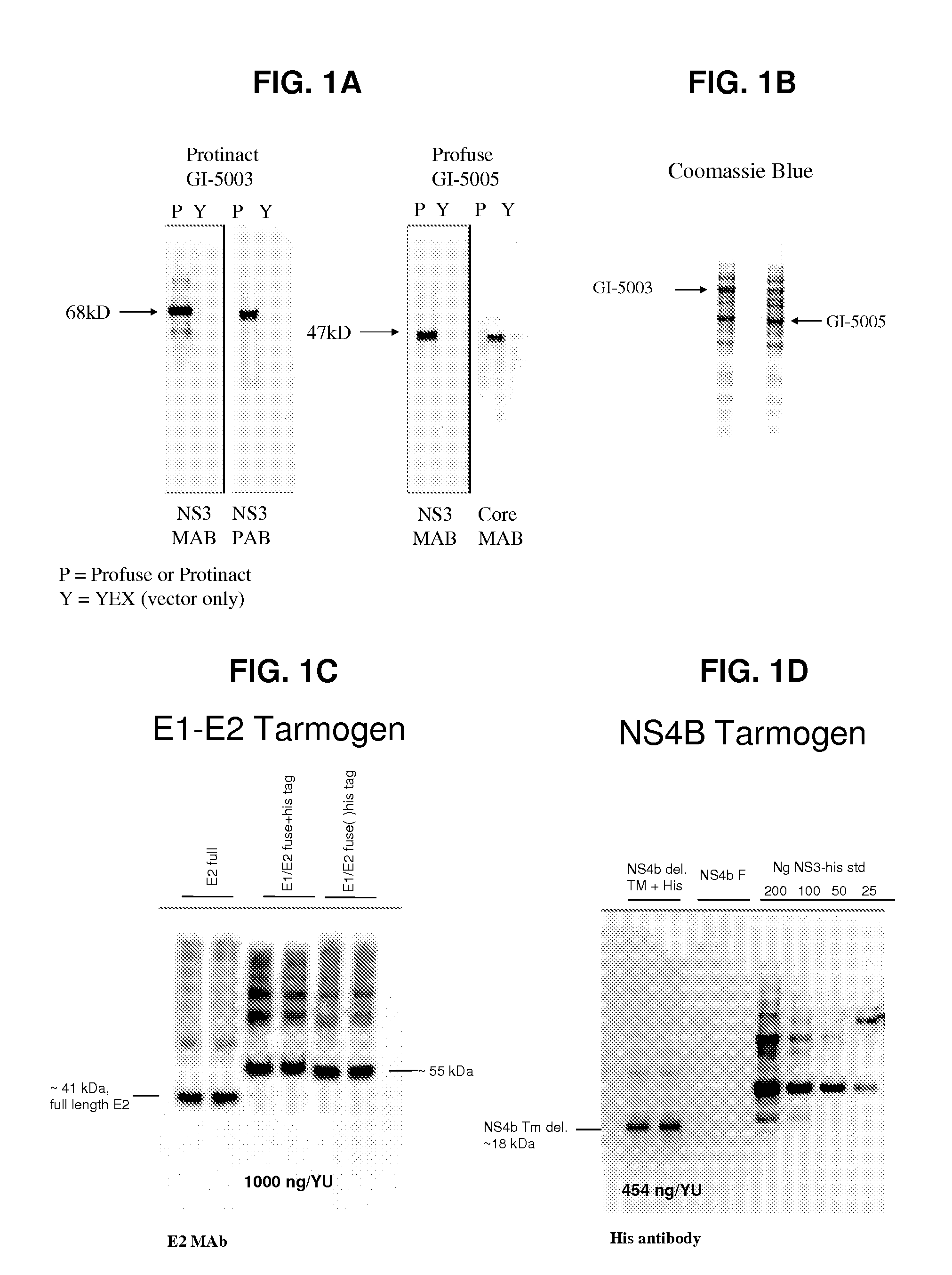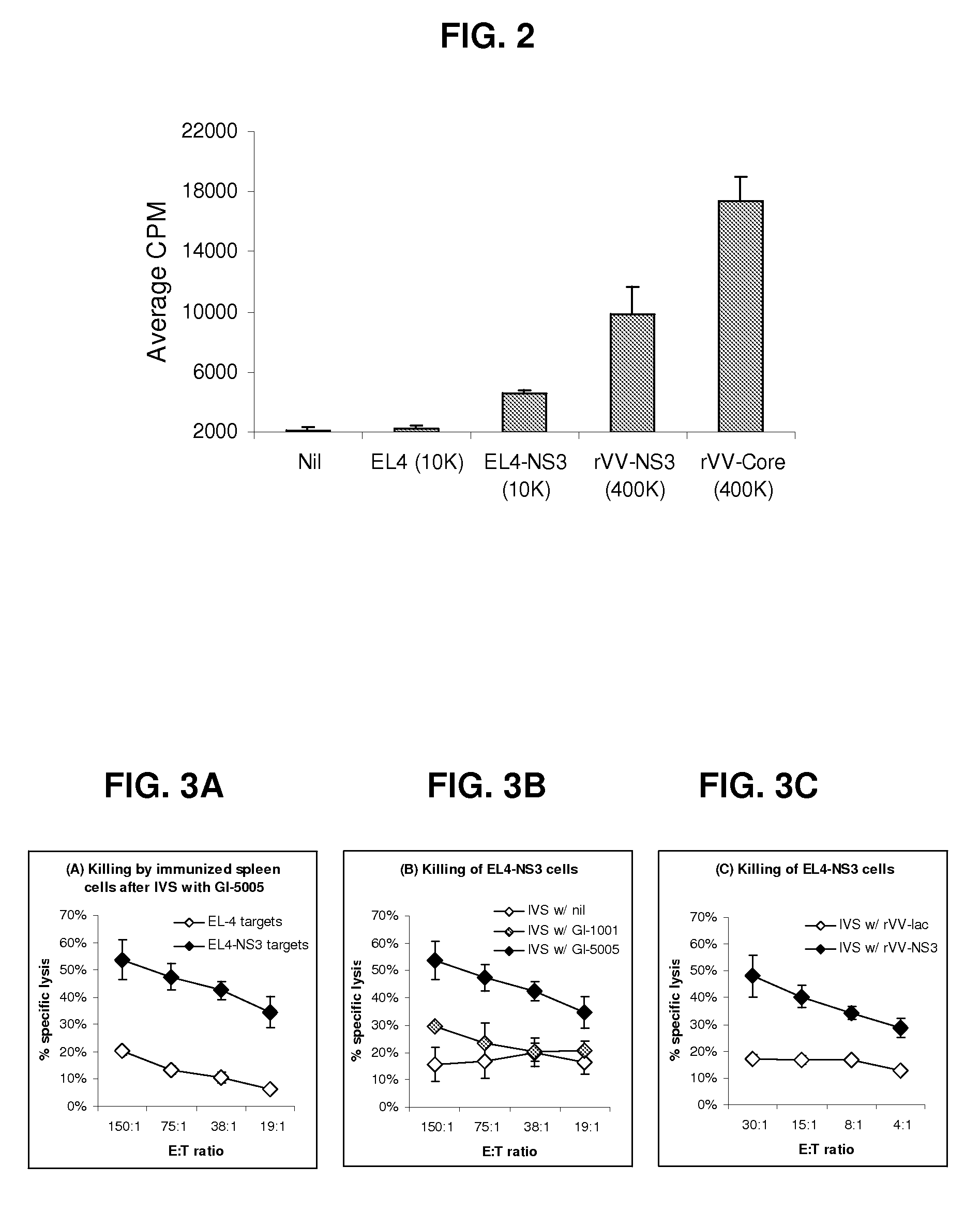Yeast-based therapeutic for chronic hepatitis c infection
a technology of hepatitis c infection and yeast, which is applied in the direction of antibody medical ingredients, drug compositions, peptide sources, etc., can solve the problems of sustained virologic response rate, increased infection rate, and significant safety problems of interferon plus ribavirin based regimens, so as to reduce or prevent hcv infection
- Summary
- Abstract
- Description
- Claims
- Application Information
AI Technical Summary
Benefits of technology
Problems solved by technology
Method used
Image
Examples
example 1
[0183]The following example describes the engineering of GI-5005, a truncated NS3-Core fusion protein yeast vaccine of the present invention.
[0184]The GI-5005 Saccharomyces cerevisiae was engineered to express a HCV NS3-Core fusion protein under the control of the copper-inducible promoter, CUP1. Two regions of the HCV genome (genotype 1a, H77 strain, cDNA was provided by the NIH) were amplified by PCR in order to generate the product. The NS3-Core fusion protein is a single polypeptide with the following sequence elements fused in frame from N- to C-terminus (HCV polyprotein numbering in parentheses) (represented herein by SEQ ID NO:2): 1) the sequence MADEAP to impart resistance to proteasomal degradation; 2) amino acids 89 to 350 (1115 to 1376) of the HCV NS3 protease protein; 3) a single threonine amino acid residue introduced in cloning; 4) amino acids 2 to 140 (2 to 140) of the HCV Core protein; and 5) the sequence ED to increase the hydrophilicity of the Core variant.
[0185]Ex...
example 2
[0186]The following example describes the engineering of GI-5003, an inactivated HCV NS3 yeast vaccine of the present invention.
[0187]The GI-5003 Saccharomyces cerevisiae was engineered to express an inactivated full-length HCV NS3 protein under the control of the copper-inducible promoter, CUP1. A single region of the HCV genome (genotype 1a, H77 strain, cDNA was provided by the NIH) was amplified by PCR in order to generate the product. The inactivated NS3 protein is a single polypeptide with the following sequence elements fused in frame from N- to C-terminus (HCV polyprotein numbering in parentheses) (represented herein by SEQ ID NO:4): 1) the sequence MADEAP to impart resistance to proteasomal degradation; and 2) amino acids 1 to 631 (1027 to 1657) of the HCV NS3 protease protein (note that the amino acid at HCV polypeptide residue 1165 has been changed from a serine to an alanine in order to inactivate the proteolytic activity).
[0188]Expression of the HCV NS3 protein was confi...
example 3
[0189]The following example describes the engineering of the GI-5000 series truncated HCV E1-E2 fusion protein yeast vaccine of the present invention.
[0190]The E1-E2 fusion protein is a single polypeptide with the following sequence elements fused in frame from N- to C-terminus (HCV polyprotein numbering in parentheses) (represented herein by SEQ ID NO:6): 1) The sequence MADEAP to impart resistance to proteasomal degradation, 2) amino acids 1 to 156 (192 to 347) of HCV protein E1, 3) amino acids 1 to 334 (384-717) of HCV protein E2. 36 C-terminal hydrophobic amino acids of E1 and 29 C-terminal hydrophobic amino acids of E2 were omitted from the fusion protein to promote cytoplasmic accumulation in yeast.
[0191]Expression of the HCV E1 / E2 fusion protein was confirmed by Western blot analysis of lysates from copper-induced, heat-inactivated yeast (See FIG. 1C).
PUM
| Property | Measurement | Unit |
|---|---|---|
| body weight | aaaaa | aaaaa |
| body weight | aaaaa | aaaaa |
| body weight | aaaaa | aaaaa |
Abstract
Description
Claims
Application Information
 Login to View More
Login to View More - R&D
- Intellectual Property
- Life Sciences
- Materials
- Tech Scout
- Unparalleled Data Quality
- Higher Quality Content
- 60% Fewer Hallucinations
Browse by: Latest US Patents, China's latest patents, Technical Efficacy Thesaurus, Application Domain, Technology Topic, Popular Technical Reports.
© 2025 PatSnap. All rights reserved.Legal|Privacy policy|Modern Slavery Act Transparency Statement|Sitemap|About US| Contact US: help@patsnap.com



